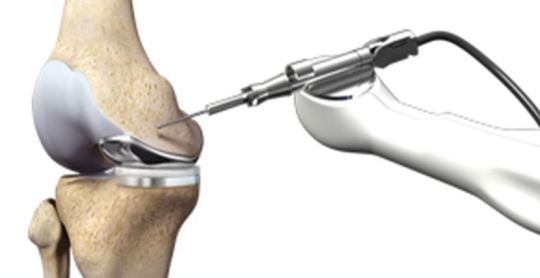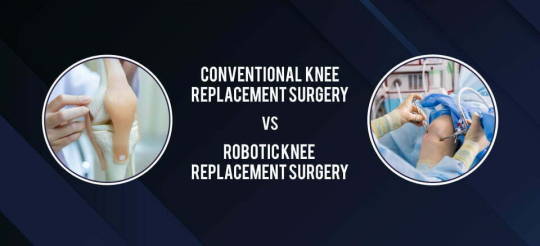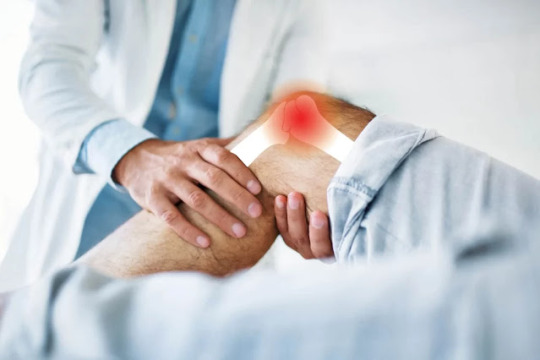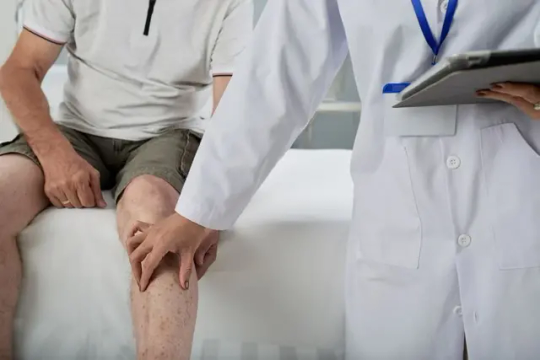#robotic knee surgery
Text
#best hospital for robotic surgery#robotic knee replacement in ahmedabad#robotic knee surgery#robotic total knee replacement#robotic orthopedic surgery
0 notes
Text
Demystifying Knee Arthroscopy: Procedure, Benefits, and Risks
In the realm of orthopedic surgery, knee arthroscopy stands out as a minimally invasive procedure that has revolutionized the treatment of various knee conditions. From diagnosing the source of knee pain to repairing damaged tissue, knee arthroscopy offers a host of benefits for patients seeking relief from knee problems. Today, let's delve into the intricacies of knee arthroscopy, exploring its procedure, benefits, and potential risks, while seamlessly integrating insights from the expertise of Dr. Saurabh Giri.

Understanding Knee Arthroscopy
Knee arthroscopy is a surgical procedure that allows orthopedic surgeons like Dr. Saurabh Giri to visualize, diagnose, and treat a wide range of knee issues through small incisions. Unlike traditional open surgery, arthroscopy involves inserting a tiny camera, called an arthroscope, into the knee joint. This camera displays real-time images on a monitor, enabling the surgeon to assess the condition of the knee and perform precise interventions.
The Procedure
Under the skilled hands of experts like Dr. Saurabh Giri, knee arthroscopy typically follows these steps:
Preparation: The patient is administered anesthesia, usually either general or regional, to ensure comfort throughout the procedure.
Incision: Small incisions, each about the size of a buttonhole, are made around the knee to insert the arthroscope and specialized surgical instruments.
Visualization: The arthroscope is inserted into the knee joint, providing a clear view of the interior structures, including the cartilage, ligaments, and meniscus.
Diagnosis: Dr. Saurabh Giri meticulously examines the knee joint, identifying any abnormalities or sources of pain.
Treatment: If necessary, surgical interventions such as trimming torn cartilage, repairing ligaments, or removing loose bodies are performed using miniature instruments.
Closure: Once the procedure is complete, the incisions are closed with sutures or adhesive strips, and a sterile dressing is applied.
Benefits of Knee Arthroscopy
Minimally Invasive: Compared to traditional open surgery, knee arthroscopy requires smaller incisions, resulting in less tissue damage, reduced pain, and faster recovery times.
Accurate Diagnosis: The high-definition images provided by the arthroscope allow for precise diagnosis of knee conditions, enabling targeted treatment strategies.
Quicker Recovery: Patients undergoing knee arthroscopy typically experience shorter hospital stays and quicker return to normal activities compared to traditional surgery.
Lower Risk of Complications: With its minimally invasive nature, knee arthroscopy carries a lower risk of complications such as infection and excessive bleeding.
Risks and Considerations
While knee arthroscopy is generally considered safe, it's important for patients to be aware of potential risks, including:
Infection: Though rare, there is a slight risk of infection at the surgical site.
Bleeding and Blood Clots: Some patients may experience bleeding or develop blood clots in the leg veins following surgery.
Nerve or Blood Vessel Damage: In rare cases, nerves or blood vessels near the knee joint may be injured during the procedure.
Dr. Saurabh Giri: Leading the Way in Knee Arthroscopy
As a distinguished orthopedic surgeon with over 14 years of experience, Dr. Saurabh Giri has earned a reputation for excellence in knee arthroscopy. His extensive training, including prestigious fellowships in knee arthroplasty and revision surgery, has equipped him with advanced skills and techniques in minimally invasive knee procedures.
Dr. Saurabh Giri's compassionate approach to patient care, coupled with his commitment to delivering optimal outcomes, sets him apart as a leader in the field of orthopedic surgery. Patients trust Dr. Giri not only for his expertise but also for his dedication to providing personalized treatment plans tailored to their individual needs.
Whether it's diagnosing a complex knee condition or performing intricate surgical repairs, Dr. Saurabh Giri's proficiency in knee arthroscopy ensures that patients receive the highest standard of care and the best possible results.
In conclusion, knee arthroscopy offers a gateway to effective diagnosis and treatment of knee problems, with benefits including minimally invasive surgery, accurate diagnosis, and quicker recovery. By entrusting their care to experts like Dr. Saurabh Giri, patients can embark on a journey towards restored knee health and enhanced quality of life.
0 notes
Text
youtube
Knee and hip surgery are crucial but often essential decisions for patients with rheumatoid arthritis, osteoarthritis, or more. However, the number of joint replacement surgeries is rising by 150%, as per previous years’ records. As the demand for common replacement surgeries grows, the need for cheaper, less invasive, and highly efficient surgical methods also rises. Read More At: https://www.drhemantortho.com
#Robotic Knee Replacement#Robotic Knee Replacement Surgery#Robotic Total Knee Replacement#Robotic#Robotic Hip Replacement#Knee Surgery#Robotic Knee Surgery#Robotic Doctor in Gurgaon#Youtube
0 notes
Text
7 Things You Must Know About Robotic Knee Replacement Surgery

1. Robotic knee replacement surgery is a minimally invasive procedure that uses a robotic arm to assist the surgeon in performing the operation. The robotic arm provides a high level of precision and accuracy during the surgery, resulting in a more accurate fit and better long-term outcomes.
2. The robotic arm uses a 3D model of the patient’s knee to guide the surgeon during the operation. This allows the surgeon to make more precise cuts and placements of the implant, resulting in a more accurate fit and better long-term outcomes.
3. Robotic knee replacement surgery typically results in less pain, swelling, and scarring than traditional knee replacement surgery. Patients can also expect a shorter recovery time, allowing them to return to their normal activities more quickly.
4. The procedure is suitable for people with osteoarthritis, rheumatoid arthritis, and other knee conditions that cause pain and limit mobility. However, not all patients are suitable candidates for robotic knee replacement surgery, and a thorough evaluation by a qualified orthopedic surgeon is necessary to determine eligibility.
5. The success rate of robotic knee replacement surgery is high, with a lower risk of complications compared to traditional knee replacement surgery. However, like any surgical procedure, there are still risks involved, such as infection, blood clots, and nerve damage.
6. The cost of robotic knee replacement surgery can be higher than traditional knee replacement surgery due to the use of advanced technology. However, the benefits of the procedure may outweigh the higher cost for some patients.
7. Rehabilitation and physical therapy are an essential part of the recovery process after robotic knee replacement surgery. Patients must follow a rehabilitation program to ensure that their knee heals correctly and that they regain their strength and mobility.
robotic knee replacement surgery is a safe and effective option for people with knee problems. However, patients should consult with a qualified orthopaedic surgeon to determine if the procedure is right for them.
Dr Saurabh Giri, a leading Robotic knee replacement surgeon in Pune, and the advanced technology at his disposal, you can trust that you are in capable hands. To explore your options and take the first step toward a pain-free and active lifestyle Don’t let knee pain hold you back any longer
#best robotic knee replacement#best knee replacement surgeon in pune#robotic knee surgery#robotic knee replacement surgery#robotic knee replacement surgery in pune#robotic knee replacement#best knee replacement surgery in india#knee replacement specialist in pune
0 notes
Text
Looking for advanced robotic knee surgery? Turn to The Knee Clinic Manchester for unbeatable results! Our skilled surgeons use state-of-the-art technology to perform precise and effective knee surgeries, helping you regain mobility and reduce pain. Trust us for the best service around! Call us today at 07722 646 372 & visit the website to learn more about us.

0 notes
Link

Our low cost robotic joint replacement surgery India is designed, keeping in mind the patient's needs, consolation, and, most importantly, the overall surgical operation price.
#robotic knee replacement#robotic knee surgery#robotic knee replacement cost#robotic knee replacement surgery
0 notes
Link

0 notes
Link
Queensland Orthopaedic Clinic is a group of like-minded, sub-specialist trained medical professionals providing personalised patient care. Consultations take place in Greenslopes and Springwood locations. Consultations are available at our satellite location in Nundah. Our team will help assess your injury and guide you in achieving a tailored solution.
#robotic knee brisbane#robotic knee surgery brisbane#anterior hip replacement brisbane#knee reconstruction brisbane#shoulder reconstruction brisbane#rotator cuff brisbane#shoulder replacement brisbane#shoulder dislocation brisbane#hip arthritis brisbane
2 notes
·
View notes
Text
Knee replacement surgery is a common procedure to treat arthritis and joint degeneration in the knee. It helps relieve pain and restore normal function of the knee

#knee replacement#robotic knee replacement#Robotic Partial Knee Replacement in India#Best Robotic Partial Knee Replacement in India#Robotic Knee Replacement in India#knee surgery#knee replacement surgery
2 notes
·
View notes
Text
How Robotic Joint Replacement Surgery Works?

Here learn, How Robotic Joint Replacement Surgery Works? Types of Robotic Knee Replacement. Know, What is the Recovery Time for Robotic Knee Replacement? Is There Less Pain with Robotic Knee Replacement? From Dr. Sameep Sohoni.. Top Orthopedic Doctor in Thane.
#Advantages and Disadvantages of Robotic Knee Replacement#Problems with Robotic Knee Surgery#What is the Success Rate of Robotic Knee Replacement?#Types of Robotic Knee Replacement#What is the Recovery Time for Robotic Knee Replacement?
0 notes
Text

#best hospital for robotic surgery#robotic knee surgery#robotic knee replacement in ahmedabad#orthopaedic robotic knee surgery
0 notes
Text
Advantages of Robotic Knee Replacement Surgery Over Traditional Knee Replacement Surgery By Dr. Saurabh Giri, Best Robotic Knee Replacement Surgeon in Pune
Knee replacement surgery is a common procedure designed to relieve pain and restore function in severely diseased knee joints. While traditional knee replacement has been a successful and reliable option for decades, the advent of robotic technology has introduced a new era in orthopedic surgery. Robotic knee replacement surgery offers several advantages over traditional methods, providing patients with enhanced outcomes and quicker recoveries. Let’s delve into the key benefits of opting for robotic-assisted knee replacement surgery, as explained by Dr. Saurabh Giri, the best Robotic Knee Replacement Surgeon in Pune.

1. Enhanced Precision and Accuracy
One of the most significant advantages of robotic knee replacement surgery is the enhanced precision and accuracy it offers. The robotic system uses advanced imaging techniques to create a detailed 3D model of the patient’s knee anatomy. This allows surgeons to plan the procedure meticulously, ensuring the most accurate alignment and placement of the knee implant. This level of precision is difficult to achieve with traditional methods, where manual techniques and less detailed imaging are used.
2. Personalized Surgical Plan
Robotic knee replacement surgery allows for a highly personalized surgical plan tailored to the individual patient’s anatomy. The 3D model generated by the robotic system enables surgeons to customize the implant placement based on the patient’s unique bone structure and alignment. This personalized approach leads to better fitting implants, which can enhance the longevity and functionality of the knee replacement.
3. Reduced Risk of Human Error
Robotic-assisted surgery significantly reduces the risk of human error. The robotic system provides real-time feedback and guidance to the surgeon, ensuring that each step of the procedure is executed with optimal accuracy. This minimizes the chances of errors that can occur with manual techniques, such as incorrect implant positioning or unintentional damage to surrounding tissues.
4. Minimally Invasive Techniques
Robotic knee replacement surgery often involves minimally invasive techniques, which result in smaller incisions compared to traditional methods. Smaller incisions mean less trauma to the surrounding tissues, leading to reduced blood loss during surgery, decreased postoperative pain, and lower risk of infection. Minimally invasive approaches also contribute to faster healing and shorter hospital stays.
5. Improved Postoperative Outcomes
Patients undergoing robotic knee replacement surgery typically experience improved postoperative outcomes. The precision and personalized approach of robotic surgery lead to better knee function, more natural movement, and higher patient satisfaction. Additionally, the accurate alignment and placement of the implant can result in a longer-lasting knee replacement, reducing the likelihood of needing revision surgery in the future.
6. Faster Recovery and Rehabilitation
The minimally invasive nature of robotic knee replacement surgery, combined with the precise and accurate surgical techniques, contributes to a quicker recovery and rehabilitation process. Patients often report less pain and swelling after surgery, allowing them to start physical therapy sooner and regain mobility faster. This accelerated recovery process helps patients return to their daily activities and enjoy an improved quality of life more quickly.
7. Consistency and Reproducibility
Robotic systems provide a high level of consistency and reproducibility in knee replacement surgeries. The technology ensures that each procedure follows the same precise steps, regardless of the surgeon’s experience level. This consistency leads to uniformly successful outcomes, giving patients confidence in the reliability of the robotic-assisted approach.
Expert Insight from Dr. Saurabh Giri — Best Knee Replacement Surgeon in Pune
To provide further clarity on robotic knee replacement surgery, we turn to the expertise of Dr. Saurabh Giri, a leading joint replacement and arthroscopy surgeon practicing in Pune and PCMC.
About Dr. Saurabh Giri
Dr. Saurabh Giri currently serves as the Head of Department for Robotic Joint Replacement at Deccan Hardikar Hospital and Accord Hospital. He also consults at ONP Prime Hospital and Sahyadri Hospitals. With over 14 years of experience, Dr. Giri has performed more than 6000 surgeries, including numerous successful robotic knee replacements. His international experience includes working at Santo Spirito Hospital in Italy and Helios Endo Klinik in Germany.
Dr. Giri emphasizes the importance of individualized treatment plans and the potential for excellent outcomes with robotic knee replacement surgery. He is committed to providing compassionate care and ensuring the best possible results for his patients.
Qualifications and Areas of Expertise
Dr. Giri’s qualifications are extensive:
MS Orthopaedic (Gold Medalist)
SICOT Fellow Hip and Knee Arthroplasty, Italy
Fellowship in Revision Surgery Hip and Knee Arthroplasty, Germany
Fellowship in Joint Replacement and Reconstruction, Deenanath Mangeshkar Hospital, Pune
His areas of expertise include:
Robotic Joint Replacement Surgery
Knee Resurfacing (UKR) / Partial Knee Replacement Surgery
Joint Replacement Surgeries (Total Hip and Total Knee Replacement)
Revision Knee Replacement Surgeries
Minimal Invasive Muscle Sparing Technique (MIS) Knee Replacement Surgery
High Flexion Knee Replacement with Highflex Knee Implants
Computer Assisted Navigation Surgeries (CAN)
Patient Specific Instrumentation Surgeries (PSI)
Knee Arthroscopy
Day Care Arthroscopic Treatment of Knee Arthritis
Stem Cells and PRP (Regenerative Cell Therapy) for Knee Arthritis
Anterior Cruciate Ligament Reconstruction
Posterior Cruciate Ligament Reconstruction
Meniscus Repair
Arthroscopic Microfracture and Cartilage Repair Technique
Multimodal Pain Management and Same Day Mobilization in Knee and Hip Replacement Surgery
Day Care Knee Replacement Surgery
Dr. Giri’s extensive experience and advanced techniques ensure that patients receive the best possible care and outcomes. If you’re considering knee replacement surgery, consulting with an expert like Dr. Saurabh Giri can provide you with the information and confidence needed to make an informed decision about your treatment.
Conclusion
Robotic knee replacement surgery offers numerous advantages over traditional knee replacement methods. The enhanced precision, personalized surgical plans, reduced risk of human error, minimally invasive techniques, improved postoperative outcomes, faster recovery, and consistency make robotic-assisted knee replacement an attractive option for patients seeking relief from knee pain and dysfunction. As robotic technology continues to advance, the benefits for patients will likely become even more pronounced, solidifying its place as a preferred choice in orthopedic surgery. If you’re considering knee replacement surgery, discussing the possibility of a robotic-assisted procedure with your orthopedic surgeon could be a valuable step towards achieving the best possible outcome.
Consulting with experienced professionals like Dr. Saurabh Giri, recognized as the best knee replacement surgeon in Pune, can make a significant difference in managing knee conditions effectively and ensuring optimal recovery outcomes. If you have any concerns or questions about robotic knee replacement surgery, don’t hesitate to reach out to a qualified orthopedic specialist for guidance and support.
0 notes
Text
Dr. Saurabh Giri: Your Trusted Orthopedic Surgeon for Joint Pain Treatment in Pune

Joint pain can significantly affect our daily lives, hindering our mobility and causing discomfort. If you’re experiencing joint pain, it’s essential to seek proper medical attention to diagnose and treat the underlying cause. In Pune, one name stands out in the field of orthopedics—Dr. Saurabh Giri. With his expertise and commitment to patient care, Dr. Giri has become a trusted orthopedic surgeon
specializing in joint pain treatment in the PCMC region.
Understanding Joint Pain:
Joint pain refers to discomfort, soreness, or inflammation in the joints—the points where two bones meet. It can affect any part of the body, including the knees, hips, shoulders, and wrists. Joint pain can vary in severity, from mild to debilitating, and can be caused by various factors.
Causes of Joint Pain:
Arthritis: Osteoarthritis, rheumatoid arthritis, and gout are common types of arthritis that can cause joint pain. These conditions lead to inflammation, cartilage damage, and joint stiffness.
Injuries: Accidents, sports-related injuries, or repetitive motions can lead to joint pain. Sprains, strains, and fractures can cause immediate discomfort and long-term joint issues.
Overuse and Age: Overuse of joints due to repetitive activities, coupled with the natural wear and tear associated with aging, can result in joint pain.
Infections: Certain infections, such as Lyme disease, influenza, or viral hepatitis, can cause joint pain as a symptom.
Other Factors: Conditions like bursitis, tendinitis, fibromyalgia, and systemic lupus erythematosus (SLE) can also contribute to joint pain.
Surgical Alternatives for Joint Pain:
When conservative treatments such as medication, physical therapy, and lifestyle modifications fail to alleviate joint pain, surgical intervention may be necessary. Dr. Saurabh Giri offers a range of surgical alternatives to address joint pain, including:
Joint Replacement Surgery: This procedure involves replacing damaged joints with artificial implants to restore function and reduce pain.
Arthroscopy: It is a minimally invasive surgical technique that uses a small camera to visualize, diagnose, and treat joint problems.
Joint Fusion: In cases where joint replacement is not feasible, joint fusion surgery may be recommended to fuse the bones in the joint, eliminating the painful motion.
Cost of Joint Pain Treatment in Pune:
The cost of joint pain treatment can vary based on various factors, including the type of surgery required, the complexity of the case, hospital charges, and post-operative care. It is advisable to consult with Dr. Saurabh Giri to get a personalized assessment and accurate cost estimation for your specific condition.
Why Choose Dr. Saurabh Giri for Joint Pain Treatment in Pune?
Expertise and Experience: Dr. Saurabh Giri is a highly skilled orthopedic surgeon with extensive experience in treating joint pain conditions. He stays updated with the latest advancements in the field to provide the best possible care to his patients.
Patient-Centric Approach: Dr. Giri believes in a patient-centric approach, where he takes the time to understand each patient’s unique concerns and develops a personalized treatment plan accordingly. He values effective communication and ensures that his patients are well-informed and comfortable throughout the treatment process.
#knee repalcement surgery#knee replacement surgeon#knee surgery#knee operation#best knee replacement surgeon in Pune#robotic knee replacement surgery#knee replacement in Pune#robotic joint replacement#joint replacement surgery#robotic knee surgery
0 notes
Text
Joint replacement is required when all or part of a joint is worn out or arthritic. After a thorough assessment treatment is tailored to the individual patient. Call us today for Robotic Knee Surgery & visit the website to learn more about us.
0 notes
Text
Rehabilitation After Orthopedic Surgery: A Guide to Healing and Recovery

Rehabilitation after orthopedic surgery or going through a robotic knee replacement surgery in Mumbai is an important phase in the recovery journey, essential for restoring function, mobility, and overall quality of life.
Any orthopedic doctor in Thane and its procedures, such as joint replacements or ligament repairs, a structured rehabilitation plan plays a crucial role in optimizing outcomes and facilitating a successful recovery.
This article aims to provide valuable insights and practical tips to navigate the rehabilitation process effectively, empowering individuals to regain strength, mobility, and independence post-surgery.
Understanding the Importance of Rehabilitation
Recovering from orthopedic surgery necessitates a comprehensive rehabilitation plan to optimize outcomes and prevent complications. Active participation in rehabilitation has been shown to lead to faster recovery, improved functional outcomes, and a reduced risk of re-injury.
The role of orthopedic Doctor in Thane in guiding patients through this stage is paramount, ensuring personalized care and support throughout the process.
What to Expect During Rehabilitation
The rehabilitation process after robotic knee replacement surgery in Mumbai typically involves several phases, each tailored to the patient's condition and surgery type.
Acute Phase: Focuses on pain control, inflammation management, and gentle exercises to promote healing.
Recovery Phase: Aims to increase strength, endurance, and range of motion, often involving the use of assistive devices.
Strengthening Phase: Concentrates on building muscle strength through resistance training.
Functional Restoration Phase: Aims to restore functional abilities through activities like balance training and sports-specific exercises.
Tips for Successful Rehabilitation
Pre-Surgery Education: Engage in pre-surgery education to understand the surgery, recovery process, and the role of rehabilitation.
Follow Medical Instructions: Adhere to post-operative instructions provided by your medical team for optimal recovery.
Physical Therapy: Collaborate with physical therapists to follow a customized rehabilitation plan aimed at restoring function and mobility.
Pain Management: Control post-surgery pain effectively to facilitate adherence to the rehabilitation plan.
Hygiene and Wound Care: Maintain proper hygiene and wound care to prevent infections and promote healing.
Nutrition: Follow a nutrient-rich diet to aid tissue repair and overall healing.
Rest and Sleep: Ensure adequate rest and sleep to support tissue repair and regeneration.
Conclusion
Rehabilitation after orthopedic surgery or a robotic knee replacement surgery in Mumbai is a critical component of the healing process, requiring dedication, patience, and a comprehensive approach.
By actively participating in rehabilitation, following medical advice, and incorporating healthy habits into your recovery journey, you can maximize your chances of a successful recovery and return to your pre-injury activity level.
Remember, each patient's rehabilitation journey is unique, and progress should be tailored to individual needs under the guidance of a medical team.
0 notes
Text
Embracing an Active Lifestyle: The Benefits of Robotic Knee Replacement
At Brisbane Hip N Knee, under the expertise of Dr. Mahendra Meta, we specialize in advanced knee replacement surgeries, including the innovative robotic knee replacement. As the demand for improved surgical outcomes and quicker recovery times increases, robotic knee replacement has emerged as a game-changer, especially for individuals leading active lifestyles. This blog explores the benefits of robotic knee replacement and why it’s a preferred choice for many patients at our QLD knee surgery clinic.
Understanding Robotic Knee Replacement
Robotic knee replacement is a state-of-the-art procedure that utilizes robotic technology to assist surgeons in performing precise and accurate knee replacements. The process involves the use of a robotic arm, guided by the surgeon, to remove damaged tissue and place the knee implant with exceptional precision. This advanced technology enhances the accuracy of the surgery, leading to better alignment and improved functionality of the knee joint.
Benefits of Robotic Knee Replacement
1. Enhanced Precision
One of the primary benefits of robotic knee replacement is the enhanced precision it offers. The robotic system allows for meticulous planning and execution of the surgery, ensuring that the knee implant is placed with utmost accuracy. This precision reduces the risk of implant misalignment, which can lead to complications and a shorter lifespan of the implant.
2. Customized Surgery
Robotic knee replacement provides a customized approach to surgery. The system uses pre-operative imaging to create a 3D model of the patient’s knee, allowing the surgeon to plan the procedure tailored to the patient’s unique anatomy. This personalized approach results in a better fit and more natural movement of the knee joint post-surgery.
3. Reduced Pain and Faster Recovery
Patients who undergo robotic knee replacement often experience less pain and a faster recovery compared to traditional knee replacement surgeries. The precision of the robotic system minimizes trauma to surrounding tissues, leading to reduced post-operative pain and swelling. Additionally, the accurate placement of the implant facilitates quicker rehabilitation and a faster return to daily activities.
4. Improved Long-term Outcomes
The precision and customization of robotic knee replacement contribute to improved long-term outcomes. Proper alignment and fit of the implant enhance its durability and functionality, reducing the likelihood of wear and the need for revision surgery. This is particularly beneficial for individuals with active lifestyles, as they can enjoy a more robust and longer-lasting knee joint.
5. Minimally Invasive Approach
Robotic knee replacement often involves a minimally invasive approach, resulting in smaller incisions and less tissue damage. This leads to a shorter hospital stay, quicker recovery, and less visible scarring. For active individuals, this means getting back to their regular activities and sports much sooner.
Why Choose Brisbane Hip N Knee for Robotic Knee Replacement?
At Brisbane Hip N Knee, Dr. Mahendra Meta and our team are dedicated to providing the highest standard of care using the latest advancements in knee surgery. Our QLD knee surgery clinic is equipped with cutting-edge robotic technology, ensuring that our patients receive the best possible outcomes. Dr. Meta’s expertise in robotic knee replacement ensures that each procedure is performed with precision, care, and a focus on the patient’s individual needs.
Conclusion
Robotic knee replacement is revolutionizing the way knee surgeries are performed, offering numerous benefits for patients, especially those with active lifestyles. Enhanced precision, customized surgery, reduced pain, faster recovery, improved long-term outcomes, and a minimally invasive approach make robotic knee replacement a superior option. At Brisbane Hip N Knee, we are committed to helping our patients achieve optimal results and regain their active lives.
For expert consultation and advanced knee surgery options, book an appointment with Dr. Mahendra Meta at Brisbane Hip N Knee today! Embrace the future of knee replacement surgery and take the first step towards a pain-free, active lifestyle.
0 notes